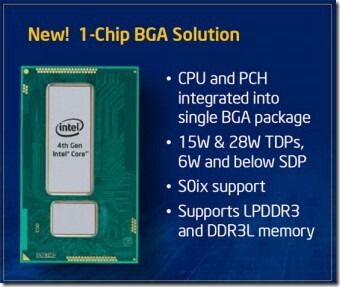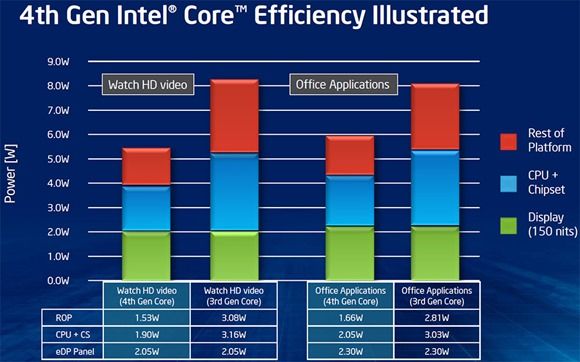Ultrabooks. Copies of the MacBook Air. Expensive laptops. Bringing nothing new to the table. I’ve read it all and discussed it all but knew from day 1 that there would be something special coming. Having followed Atom from day 1 to the point where Moorestown finally got the architecture right I knew what Intel could achieve. Haswell was built with the next generation laptop in mind. It’s HDR-Computing with Connected Standby, some of the best integrated graphics on the market, video engines that can process end-to-end 4K and TDP’s that will allow manufacturers to design PCs you never thought were possible. With Haswell, Ultrabooks get meaning.
The 1-chip, dual package solution you see above is ugly. It’s unique though and it’s only for U and Y-Series Haswell parts which are almost exclusive to the Ultrabook, dockable and Windows tablet market. It’s not only the look of the platform that’s unique though.
It has dual-slice graphics which can be likened to dual-cores. HD5000 and HD5200 (Intel Iris) will appear in Ultrabooks although the Iris Pro graphics isn’t offered in this small package presumably because of thermal cooling requirements. It’s too hot for ultra mobile designs. Within HD500 and HD5200 you’ll find up to 2X GPU performance though and some unique features.
Mid-range laptops using Haswell won’t get the dual-slice graphics. They won’t get S0ix support either.
S0ix is a capability that indicates a brand new level of power management. It’s the capability that is required to support Connected Standby (CS) and a completely new way of using the power button.
You might not want to have your PC on all the time but trust me, the engineering required to do it means you’re getting the most advanced mainboard design you can possibly have. It’s the mark of efficiency and should really be branded with a flashy name. You might see that happen over the next few days. “Intel HDR” wouldn’t be far from the mark as a brand for CS-capable products.
Speaking of HDR, think about what you’re getting here. A system that will idle for many days like a smartphone but can be ready to process a stream of 1080p videos for YouTube in 8x real-time. A system that could be powered by the sun in idle and then burn through a few hours of high-end gaming on a 1080p screen. This level of HDR computing has never been seen before and it will be unique to Ultrabooks.
Even without Connected Standby you’re going to get some amazing improvements in battery life. I’m sometimes sceptical of huge battery life claims but given what Intel have already achieved with the Atom Clovetrail platform for Windows 8 I have no reason to doubt these figures. In fact, with the smaller and more efficient screens (screen backlight is a huge battery drain that ARM, Intel and everyone has to fight with) the advantages are going to be even greater.
Single-chip Intel 4th-Gen Core platforms will be available in 10W TDP designs too. Y-Series Core generates so little heat that it could fit into a netbook and yet offer processing power that is enough for all-day desktop work. There’s a slim possibility that you’ll get fanless designs too. A silent Ultrabook driving 4K content through a DP1.2 port, even if it was a bit larger than a normal Ultrabook, would be something special. These Y-Series parts won’t be available immediately however but Intel appear to be promising them for sometime in 2013.
There are two SKUs available initially but 19 are planned. That will include VPro+i3,i5,i7 variants at 15w TDP and then new 28W TDP versions with Iris Graphics. (which is also CS-capable for making the ultimate HDR PC.) We’ve already seen an HD4500 and HD4558U mentioned in product announcements and leaks.
All Ultrabooks on 4th-Gen Cores will have touch. All will have Miracast and WiDi 4.1 support, all will have Intel Identity Protection Technology (IPT) and Anti Theft technology and all will ship with anti-malware and anti-virus software.
A list of Haswell Ultrabooks – We’ve broken out a new section of our product database to list Haswell Ultrabooks. As of today we only have two leaked models in the list but expect that to grow during Computex. (Starting June 2nd.)
Ultrabooks were always efficient, always used best engineering practices (well, at least on most Ultrabooks!) and were always the most mobile of laptops but there was no crystal-clear advantage for most people. With new power management comes amazing new battery life capability that will be head and shoulders above ‘old’ laptop designs. The GPU performance including 4K support, video transcoding power and true gaming capability is going to be stunning and the guarantee of touch, wireless display and security features is going to set them apart. Y-series Haswell will bring 10mm thick tablets and convertible designs that really can take on the battery life of ARM-based tablets. All of these features are things that customers can relate to and thus the Ultrabook now has real meaning.
Our Ultrabook 2013 market report is here. We predict 40 million sales during 2013.
Join us for news and discussion from Computex which starts as the sun rises next in Taipei.
Hat-tip: PCPer have a good summary of the Y and U-series features.















Can I have SOix on my Intel Desktop PC please, connected standby?
And a start in less than 3 seconds from Suspend-to-Ram (S3)?
If you’re looking to buy a new desktop then just get a cheaper Ivy Bridge system. Performance and power consumption differences won’t be noticeable. Then you can pocket the saved money or use it on other components.
Unfortunately not but if you’re not doing anything too crazy an Ultrabook can easily work as a desktop.
What are the chances that one of these 28 W TDP chips is a quad core with HD 4×00 graphics? For what I do, I’m more multi-threaded CPU bound (virtualization, multi-threaded C/C++ numerical applications, MATLAB and software based video encoding).
Also, the M chips aren’t getting much power consumption improvements? No S0ix? I thought the desktop chips were disappointing but even the mobile non-U/Y chips are too it seems. I don’t think I’m part of the target audience for ultrabooks but it would have been nice to have at least a long battery life M chip based notebook without the need of a battery sticking out.
I guess under Linux the U/Y chips aren’t going to help power consumption much either. That is if you can actually boot into that ISO. I guess Windows isn’t bloated anymore or the lack of manufacturer support for Linux has caught up.
Ya, it definitely would be nice if one of the higher ~28 W TDP chips opted for a quad core and an HD 4×00 instead of the Iris GPU like you said.
The M series should have gotten the same power consumption improvements as well. Not everyone who needs long battery life requires an ultrabook.
28W chip has a TDP that high because it has the Iris 5100 GPU, while the 15W has the HD 5000.
And I disagree with M series needing same power usage improvements as the U and Y.
If Tablets are really going to take over traditional Desktop and Laptop systems, Intel needs to do at LEAST what they are doing now, if not more.
With Broadwell, dual core M chips entirely disappear as well.
But then I can stay with my current SandyBridge system. And rather buy an LED Monitor, get rid of the old LCD with CFL backlight and save 30W.
The point was IF you’re going for a new system then just get one with a previous generation Intel chip. Desktop Haswell chips don’t gain much in performance and power consumption over previous generations. At least not enough to matter. Desktop Haswell definitely isn’t enough to upgrade from a Sandy Bridge system.
If you plan on gaming then you’re better off still getting a discrete card over an Iris Pro system. Especially who knows how much those systems will cost since you have to buy them soldered on a motherboard.
The mandatory touch screen thing was the only dumb move here. Cost is still a MAJOR roadblock to adoption and with these specs the ultrabook pricing isn’t going anywhere anytime soon.
It would’v been nice if Haswell could have launched with more power efficient LCD designs, too.
I’d love to see a non-touch, 1080p, reasonably priced Haswell ultrabook.
Adam
No way.
Lot of people have complained that Ultrabooks didn’t have big enough differentiators, and even that touch screen should be more widespread with Windows 8. Quite a few people like touch on Clamshell-only form factors even in Desktop mode too.
You, personally can always buy something else.
Can anybody tell me approximately when will the (lenovo) haswell ultrabooks launch in India